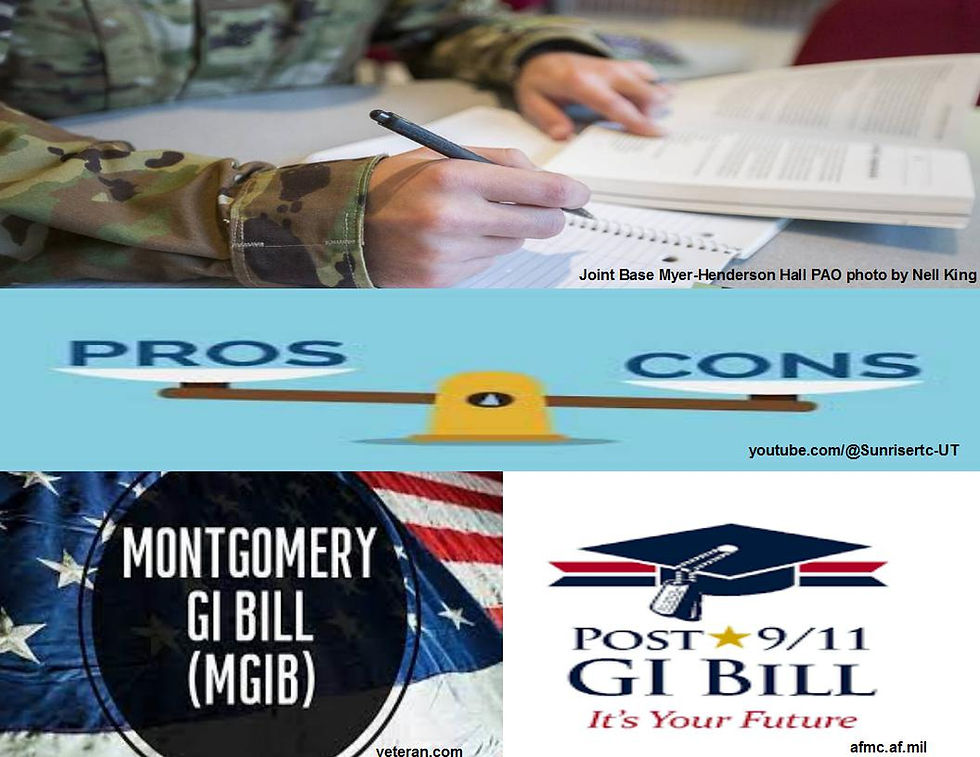For 2023 – Understand The Differences Between GI Bill Education Benefits Programs
- Ken Larson

- Dec 31, 2022
- 3 min read

“MILITARY TIMES” By Harm Venhuizen
“When pursuing an education after the military, veterans are often faced with the choice between using the Montgomery GI Bill or the Post-9/11 GI Bill. Which of these benefits is right for you depends on your educational goals and service history.
Veterans eligible for both the Montgomery and Post-9/11 GI Bills have to do the math on which will provide the most assistance in their situation.”
________________________________________________________________________________
“Both the Montgomery and the Post-9/11 GI Bills offer up to 36 months of tuition assistance, but eligibility and payment structures differ. Although veterans can only use one GI Bill at a time, those eligible for both programs can extend their benefits to a maximum of 48 months, receiving another benefit for 12 months.
Post-9/11 GI Bill
Under the Post-9/11 GI Bill, the VA will pay up to the in-state tuition price tag of public universities. For veterans enrolled in a private institution, tuition assistance is capped at a current national maximum of $26,042.81.
The Post-9/11 GI Bill also offers benefits including a monthly housing allowance, annual book stipend of up to $1,000, and a one-time relocation payment for eligible recipients.
The monthly housing allowance is typically the same as the basic allowance for housing that an E-5 with dependents would receive in the same zip code.
For veterans who separated prior to Jan. 1, 2013, Post-9/11 GI Bill benefits expire 15 years after separation, but the “Forever GI Bill” passed in 2017 removed this limitation for servicemembers separating after Jan. 1, 2013.
Post-9/11 GI Bill benefits can also be transferred to the servicemember’s dependents.
Veterans receiving Post-9/11 GI Bill benefits can also apply to school with a Yellow Ribbon program, which helps cover the gap between benefits and out-of-state tuition, graduate school tuition, or costs at private institutions. Only certain schools have Yellow Ribbon agreements with the VA, so be sure to check with your desired institution first.
The Montgomery GI Bill
The Montgomery GI Bill breaks down into two types, the MGIB Active Duty and the MGIB Selected Reserve. MGIB-SR benefits, which are open to members of reserve and National Guard forces, pay a flat-rate check of $397 to full-time students each month.
The MGIB-AD, however, offers up to a $2,122 monthly rate. These rates change each year.
Instead of paying tuition benefits to the school, as the Post-9/11 GI Bill does, the MGIB sends a monthly check directly to the student. Students are not eligible for housing allowances or book stipends and cannot receive additional funds through the Yellow Ribbon Program. MGIB benefits cannot be transferred to dependents.
While on active duty, the MGIB offers a buy-up program for servicemembers to contribute to. Servicemembers who paid into this fund to increase their benefits can only use their contributions under the MGIB.
So, which GI Bill is better?
In most scenarios, the Post-9/11 GI Bill offers veteran students more financial assistance than the MGIB, especially when pursuing a standard, four-year degree at an accredited higher learning institution or passing your benefits to a dependent. There are a few exceptions, however. Namely:
Taking tests: When pursuing a license or paying for a standardized test, the Post-9/11 GI Bill may charge you a greater amount of benefits entitlement than the MGIB. This depends on the cost of the test and varies by scenario.
Part-time students: If you’re only taking classes part time, it may be more beneficial to use MGIB benefits. This is because the Post-9/11 GI Bill doesn’t pay monthly housing allowances to students with a rate of pursuit under 50 percent. Tuition assistance is then paid relative to the rate of pursuit. Under the MGIB, lower percentages of benefits could wind up giving you more cash than receiving the Post-9/11 GI Bill without a housing allowance would.
Ineligible for 100% of the Post-9/11 GI Bill: Veterans who didn’t serve on active duty for more than 36 months aren’t eligible for 100% of the Post-9/11 GI Bill. The Post-9/11 GI Bill pro-rates your allowances based on the amount of time you did serve on active duty, whereas the MGIB allows veterans to make a lump-sum contribution to close the gap between their time served and 100-percent eligibility requirements.
Online classes: If taking online classes with a low cost per credit, veterans can pocket more cash by taking advantage of their MGIB benefits instead of the Post-9/11 GI Bill. This is because the Post-9/11 GI Bill limits the housing allowance paid to students who are entirely online.
For veterans thinking about using their GI Bill benefits to pursue an education, the smartest thing to do is research options well in advance.
Every veteran has unique educational goals and circumstances, so there’s no one-size-fits-all approach to using your GI Bill.”
About Harm Venhuizen
Harm Venhuizen is an editorial intern at Military Times. He is studying political science and philosophy at Calvin University, where he’s also in the Army ROTC program.




Comments